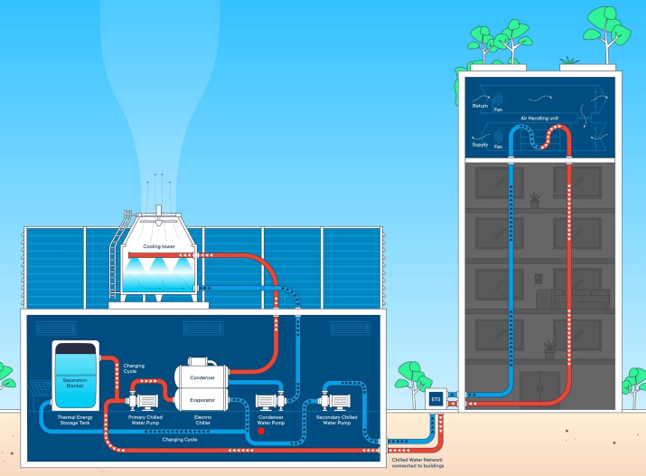The District Cooling system provides efficient and sustainable cooling to multiple buildings through a centralized cooling plant that generates chilled water by using a series of key components such as chillers, pumps, and cooling towers etc. The District Cooling plant ensures consistent cooling across connected buildings, optimizing energy use and reducing the need for individual cooling equipment.
Chilling the Water in the Chiller: The process begins at the chiller. The chiller uses a refrigerant to cool water in the evaporator. The refrigerant absorbs heat from the water, reducing its temperature. The refrigerant then goes to the condenser, where it releases heat and gets ready for the next cycle.
Pumping Chilled Water to Buildings: Once the water is chilled, it is pumped through a series of insulated pipes (network) using Secondary Chilled Water Pumps. These pipes transport the cold water to various buildings while minimizing temperature loss.
Energy Transfer to Building Systems: The cold water arrives at each building’s Energy Transfer Station (ETS) which comprises of plate type heat exchangers, pumps etc. The ETS connects the District Cooling network to the building’s internal chilled water circuit (while isolating both the circuits) feeding HVAC systems (such as air handlers or fan coil units), which uses this chilled water to cool the air inside the building.
Return of Warmed Water to Central Plant: As the District Cooling network chilled water absorbs heat from the buildings via ETS, it warms up. This warm water is then returned to the District Cooling plant for re-chilling through a separate set of return pipes.
Heat Rejection in the Cooling Tower: In the District Cooling plant, the warm water is sent to the chiller for next cooling cycle while this heat is dispersed into the environment via cooling towers. This completes the cycle, allowing it to continue.

